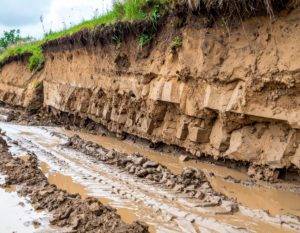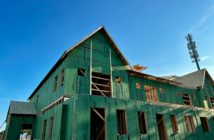We have learned a lot from Cyclone Gabrielle, and developed good policies and guidelines as a result, but some aspects of the Building Act still need to change to put them into practice, says University of Auckland Associate Professor Martin Brook

One year on from the devastating Auckland Anniversary storm and Cyclone Gabrielle, many stories of misery and financial disasters have emerged. It’s important to reflect on the impact of those events on individuals and communities, but also on what knowledge has emerged over the last year, what we have learned from recent history, and what scientific advances have been made.
It has been reported that the early 2023 storm events caused more than 140,000 landslides, and possibly as many as 800,000 landslides, and though a large portion of these landslides were in unpopulated hill country, many landslides were in populated suburbs in cities and townships. In addition, flooding from the storms inundated areas of Auckland and parts of the eastern North Island. If there is a silver lining to those devastating events, we have learned a lot and there have been several important responses to these storms over the last year.
First, while immensely damaging to people, communities and the economy, the massive amount of landslides across such large areas has provided an unprecedented opportunity to analyse landslides, from several standpoints, including: the mechanisms of how the slope failed; locational factors such as slope angle; and the amount and rates of local rainfall and the soil or rock properties of where the landslides occurred.
This research has been undertaken by the universities and crown research institutes, such as GNS Science. This is using new satellite data and laser scans of the land surface, which can determine volumes of displaced material, from comparing “before” and “after” digital elevation models. In some areas of the eastern North Island, such as Esk Valley, more than 150 landslides per square kilometre have been identified. That is an extremely high density of landsliding, which led to substantial soil erosion. In theory, all of this landslide and erosion research conducted over the last year should be used to improve hazard zoning and setback distances in future.
Second, central government passed into law the Severe Weather Emergency Legislation Act on March 20, 2023 and the Severe Weather Emergency Recovery Legislation Act on April 12. These changes modified the existing Resource Management Act and provided more flexibility for councils to assist affected communities to recover.
Third, local government, via subcontracting teams of experienced geotechnical engineers and engineering geologists, have been busy undertaking the land categorisation (1, 2A, 2P, 2C, 3). Category 3 is a buyout, 2P allows some funding of mitigation for individual properties, and 2C provided for community-based mitigation schemes (a flood embankment, for example).
Fourth, a new 84-page Landslide Planning Guidance document, Reducing Landslide Risk through Land-use Planning was published in January 2024 – a joint project by GNS, MBIE, EQC and industry specialists from the New Zealand Geotechnical Society. The 12 key messages listed inside the front cover should be salient messages to anyone involved in land development.
Notwithstanding the policy responses and science that has emerged over the last 12 months, the major challenge in New Zealand continues: the best, world-leading science can have minimal if any real-world impact here, because of the law.
My colleague Associate Professor Murray Ford identified 15m of coastal erosion caused by Cyclone Gabrielle at Whangamatā. Murray said that “Development along the coast must be cognisant of the hazards which might impact the coast, both now and in the future”.
I agree, but though being cognisant of hazards may seem to be obvious when building and developing land, a seemingly intractable problem in New Zealand is the Building Act 2004.
Within the act, hazards are not necessarily something to be too concerned about. Indeed, Section 72 of the Building Act (2004) requires a building consent authority that is also a territorial authority to grant a consent provided the building consent authority considers that:
- the building work will not accelerate, worsen, or result in a natural hazard on the land or on any other property; and
- the land is subject or is likely to be subject to one or more natural hazards; and
- it is reasonable to grant a waiver or modification of the building code in respect of the natural hazard concerned.
Thus, Section 72 accepts that an existing risk of natural hazard (for example coastal erosion/land sliding) should not prevent building work going ahead, as long as the work will not make the situation worse. The clear implication is that Section 72 allows land developers and lawyers, who will push the law to its limits in court if necessary, to build a house on land subject to natural hazards, and sell it, often to unsuspecting buyers. The law really can be an ass, and if we are to learn from the tragic events of 2023, some of it, particularly pertaining to building consents, needs to change.
Of course Gabrielle revealed the hazards that emergency personnel were exposed to during responses to the storms, which was highlighted in July 2023 when Fire and Emergency New Zealand released an independent report into the deaths of two firefighters on February 13 in Muriwai, Auckland, during Cyclone Gabrielle.
The report found that “FENZ’s risk management systems did not identify landslides as a hazard that could harm its firefighters, which resulted in a lack of landslide related procedures and training for firefighters. The Muriwai firefighters knew about Muriwai’s general susceptibility to landslides but did not recognise the warning signs that indicated an imminent landslide threat”.
This raises the question that improved training may be needed for FENZ personnel in future, given New Zealand’s hilly terrain, and susceptibility to a wide range of landslide types.Some countries, for example Sweden, have long recognised the risk of landslides to emergency crews, and in 2013 Sweden published a Response Guideline for Landslides for rescue personnel.
Developing something similar may be useful in New Zealand, and indeed the FENZ report does state that on May 5, 2023 they issued a national safety notice on “Safety around landslips and land subsidence” to all operational personnel. The contents of this are unknown, but I would hope this will be an extremely valuable safety notice for responses to similar events to those in early 2023.









